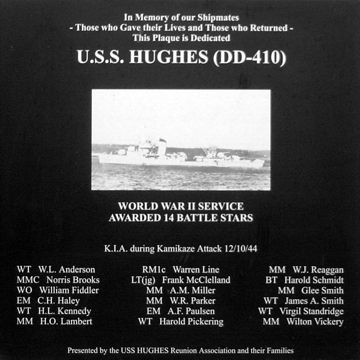

Memorial Wall plaque
National Museum of the Pacific War,
Fredericksburg, Texas.
For much of the first part of 1942, Hughes served with aircraft carrier Yorktown (CV 5). Though she was absent during the Battle of the Coral Sea in early May, she accompanied Yorktown in the Battle of Midway a month later, stood by the disabled carrier after she had been hit and abandoned, and was present when she sank on 7 June. During much of the Guadalcanal campaign that began in August 1942, Hughes worked with carriers Enterprise (CV 6) and Hornet (CV 8), taking part in the Battle of the Santa Cruz Islands in late October and the Naval Battle of Guadalcanal in mid-November 1942.
Hughes left the south Pacific in early 1943 and was sent to the Aleutians. She took part in two bombardments of Kiska Island during July and remained in that northern area until late August. Her next combat operation was the Gilberts invasion, during which she rescued many survivors of the escort carrier Liscombe Bay, sunk off Makin Atoll on 24 November 1943. In January–April 1944, Hughes continued to serve with escort carriers during the amphibious assaults on the Marshall Islands and Hollandia, New Guinea. Continuing operations off New Guinea until mid-September, she supported several more amphibious operations and escorted convoys.
In October 1944, Hughes took part in the invasion of Leyte and subsequent operations in support of the Leyte campaign. While participating in the Ormoc Bay landings in December 1944, she was badly damaged by a Japanese suicide plane and had to return to the west coast for repairs. This work was completed in June 1945, and Hughes was sent to the Aleutians, where she remained until fighting ended in August. She was briefly employed on patrol duties off northern Japan until mid-October. Her last active service was as part of the target group during the Bikini Atomic Tests in July 1946. Decommissioned a month later, Hughes was sunk as a target in October 1948—the last of the Sims-class destroyers.
Source: Naval Historical Center including Dictionary of American Naval Fighting Ships.